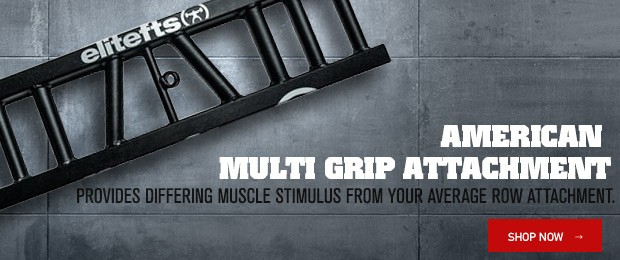
In one of our recently featured elitefts videos, David Tate and JL Holdsworth discussed the long-term consequences of heavy training and back injuries as well as the ramifications relative to spinal health and long-term quality of lifting and life. There have been many articles written about how to “bulletproof your back.” For example, Joe Schillero wrote an excellent one some months back about upper back development. What I'm presenting here isn't anything revolutionary. It's just a different perspective on muscle building relative to back development.
In my last article, one of the concepts that I discussed was “direct joint compression.” When joints are excessively stressed, I believe that muscle growth is inhibited. Hence, if hypertrophy is the operative goal, my methodology is centered around maximizing mechanical tension on the muscle while minimizing stress on the joint. Relative to the spine then, I want to perform movements that subject the spine to a minimum amount of compression, torque and sheer force.
WATCH: Table Talk — How to Maintain a Healthy Spine
Now, the criticism to this is that the bones and joints won’t be strengthened. This isn't true. All back exercises no matter how spine “friendly” will subject the spine to force to some degree. By keeping this stress to a minimum, we can encourage continuous positive adaptations to the bones and tendons while never extensively overloading them.
All that said, when training the back, I want my clients to feel it in the muscles. I don’t want them coming in with feedback that their lower backs are thrashed or that it feels like their spines got crunched.
Now, my clients aren't powerlifters. But even for powerlifters, these principles still apply. The healthier you can keep your spine, the longer you can train heavy on your primary lifts. The stronger you can get relative to the long term, the less of an old, banged up lifter you'll be lamenting all the movements that he can’t do because he spent his younger years lifting incorrectly and now he's paying for it. So with some context in place, let's go to the exercises themselves.
My Top-10, Spine-Friendly Back Exercises
These movements aren't listed in order of “best to worst” or anything like that. It's simply a list of 10 movements because that is how many I came up with when evaluating my programming with clients. These movements are performed with the intention to grow muscle (hypertrophy). While some of them could arguably be done for maxes, I’ve never found the point in trying to find a one-rep max on a movement that isn't a barbell lift. It's feeding the ego more than it's growing any additional muscle.
1. Chest supported rows: This is a staple movement in many programs and for good reason. It's easy to set up, easy to progress and “back friendly” for even the most beat up lifters. Chest supported rows can be done with cables, dumbbells, a T-bar setup and any variation thereof. Sets and reps could be 2–5 sets of 5–20 reps, depending on the implement and the intention.
2. High/low angle cable or banded rows: I'm a big proponent of balanced muscular development being the result of “global” training, where all possible angles of contraction are worked. By attaching bands at ankle level or head level, you can perform “angled” rows that can specifically target the upper, mid or low back in ways that traditional bent over dumbbell and barbell rows can't. I've found that the higher reps work best for these. Do 2–5 sets of 10–20 reps.
3. Banded good morning: This is a movement that I picked up from Chase Karnes' log about two years ago. Banded good mornings can actually be done with a significant amount of band tension (start with an orange band, add red, then add green, then two oranges and so on). They can significantly develop the spinal extensor muscles and can be done for extra glute and hamstring work. They can be performed as a way to groove a hinge pattern and can be done with either stiff legs or bent legs. I believe that only high reps should be used with this movement. I recommend 2–3 sets of 20–30 reps.
4. High rep barbell good mornings: This is spine friendly? Yes, yes it is. At one time, I wrote that I preferred barbell good mornings to be done for 6–10 reps, but in the past year, I've experimented with doing them for higher reps. Not only did I find this to be very effective for glute hypertrophy, but it acted as excellent conditioning for the entirety of the spinal erectors, particularly the lumbar and sacrum. How many reps? Anywhere from 10 all the way to 30. This obviously mandates that the weight used be light. The empty barbell is what I start people with and the heaviest I've had anyone go is a quarter on each side.
While the heavy good morning is something that I don't really recommend unless you're a competitive powerlifter, the high rep good morning is something that can be used for almost any population. I've gotten good results with clients using only two working sets of good mornings. Two to three sets of 10–30 reps works excellent.
5. Staggered dumbbell dead stop rows: Sometimes called lawnmower rows, I picked this movement up years ago and then I saw Shelby Starnes perform it with a dead stop. I've come to favor it, as it requires the trainee to get “set” before every rep with a stable back and firm grip. It's self-correcting if you pull the weight awkwardly. For this movement, lower reps are preferential because it does get tiring quickly. Three to four sets of 6–10 reps is what I generally utilize. Drop sets can be used very effectively with this exercise as well.
6. Dead stop barbell rows off pins: Did you think that I was going to exclude the barbell? Think again. Doing dead stop rows off pins was an old school movement that I found in an old Peary Rader column online. Similar to the dumbbell version, the barbell version forces you to be properly aligned on every rep, and it's a self-correcting movement. This is a movement that can be taken fairly slowly over time. Do 3–4 sets of 6–10 reps.
7. Weighted chin-ups/pull-ups: Spine friendly? Definitely. There's no downward compression when doing these. While weighted chin-ups and pull-ups get critiqued for being shoulder unfriendly at times, I've seen that it's more likely a larger issue of damaging training that neglects shoulder health versus the movement itself being the problem. Plus, weighted chin-ups and pull-ups are hard. They take time to perform, and they progress slowly. Too often, people automatically want to start strapping plates to their weight. Start light. An extra 10 pounds is perfectly sufficient, and use progressive overload over time. Try 3–5 sets of 5–10 reps.
8. Chest supported Y raises: I may have gotten this movement from an old Dave Tate article somewhere. Essentially, it's a front raise/overhead combination movement. It doesn't look like much, but it directly targets the lower traps and rhomboids in a way that no other movement does, even face pulls. I favor higher reps for this. Try 2–4 sets of 12–20 reps. Use light weight and emphasize range of motion and peak contraction.
9. Meadows shrugs: Guess who came up with these? Meadow shrugs are performed with a three-second peak contraction at the top of every rep. Not only does this cut down the weight you use to a weight that you can actually control, but it prolongs the time under tension significantly. John favors 3–4 sets of 12–15 reps.
10. Dumbbell deadlifts: This encompasses Romanian deadlifts, stiff legs, single legs and everything in between. Dumbbell deadlifts can act as a “max effort” movement for beginner trainees and can be an excellent hypertrophy movement for those at a more intermediate and advanced level. By modifying the movement, it can be used to target the entirety of the posterior chain. I'm particularly partial to the “cobra deadlifts,” which emphasize the lats, upper back and grip. I suggest 2–6 sets of 6–10 reps.
In Summation
While this list isn't exhaustive, these movements do form my current top 10 for most effective, spine-friendly exercises. Hopefully, they give you ideas for your own training. Beyond that, perhaps you'll have a different perspective toward your long-term gains and strength and muscle development.











5 Comments